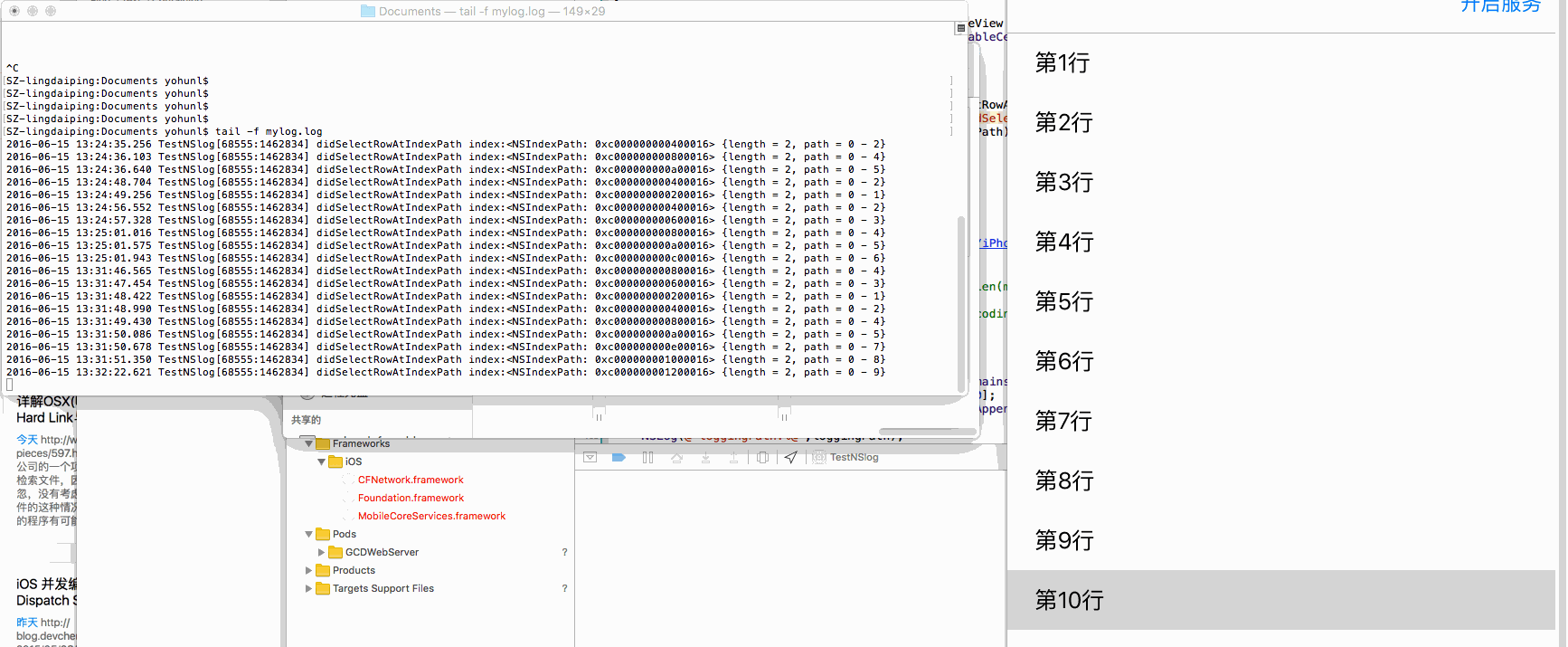iOS日志获取和实时浏览器显示日志

投稿文章,作者:yohunl(微博)
平时我们写代码的时候,为了调试方便,总是会在代码中写入很多的NSLog(也可能是其它的日志框架等,例如大名鼎鼎的 CocoaLumberjack ),但是我们对于NSLog到底了解多少?NSLog的信息为什么Xcode能够获取的到?我们能自己写个程序获取所有的NSlog么?NSLog写入的信息到底在哪里?
NSLog输出到哪?
我们都知道,NSLog是一个C函数,它的函数声明是
void NSLog(NSString *format, ...)
系统对其说明是:Logs an error message to the Apple System Log facility.,它是用来输出信息到标准的Error控制台上去.其内部其实是使用Apple System Log(ASL:苹果自己实现的输出日志的一套接口)的API.在iOS真机设备上,使用ASL记录的log被缓存在一个文件中,直到设备被重启。
这里提到的ASL,都是放在ash.h这个头文件中,这套api可以获取指定的日志数据,具体可以参考 ASL参考 。
从上面可以直到,NSLog默认被系统输出到了一个文件中,这个文件是哪个呢?NSLog默认的输出到了系统的 /var/log/syslog这个文件中,当然了,如果你的机器没有越狱,你是查看不了这个文件的.我手机是越狱的,于是乎验证了下,使用iTools等工具将真机的/var/log/syslog文件导出,下面就是这个文件的部分内容的截取 log.png 从中,我们可以看到,所有的APP的NSLog全部都是写到这个文件中的!!!

标准的err控制台
我们现在了解到了NSLog就是输出到文件syslog中,既然要往文件中写,那么肯定就有文件的句柄了,这个文件的句柄是多少呢? 在C语言中,我们有三个默认的句柄
#define stdin __stdinp #define stdout __stdoutp #define stderr __stderrp
其对应的iOS系统层面的上述三个句柄其实也就是下面的三个
#define STDIN_FILENO 0 /* standard input file descriptor */ #define STDOUT_FILENO 1 /* standard output file descriptor */ #define STDERR_FILENO 2 /* standard error file descriptor */
我们的NSLog输出的是到 STDERR_FILENO 上,我们可以使用c语言的输出到文件的fprintf来验证一下
NSLog(@"ViewController viewDidLoad"); fprintf (stderr, "%s/n", "ViewController viewDidLoad222");
在Xcode的控制台可以看到输出
2016-06-15 12:57:17.286 TestNSlog[68073:1441419] ViewController viewDidLoad ViewController viewDidLoad222
由于fprintf并不会像NSLog那样,在内部调用ASL接口,所以只是单纯的输出信息,并没有添加日期,进程名,进程id等,也不会自动换行。
NSLog的重定向
既然NSLog是写到STDERR_FILENO中去的,那么根据Unix的知识,我们可以重定向这个文件,让NSLog直接写到文件中去
//to log to document directory NSArray *paths = NSSearchPathForDirectoriesInDomains(NSDocumentDirectory, NSUserDomainMask, YES); NSString *documentsPath = [paths objectAtIndex:0]; NSString *loggingPath = [documentsPath stringByAppendingPathComponent:@"/mylog.log"]; //redirect NSLog freopen([loggingPath cStringUsingEncoding:NSASCIIStringEncoding], "a+", stderr);
利用c语言的freopen函数,进行重定向,将写往stderr的内容重定向到我们制定的文件中去,一旦执行了上述代码,那么在这个之后的NSLog将不会在控制台显示了,会直接输出在文件mylog.log中! 在模拟器中,我们可以使用终端的tail命令(tail -f mylog.log)对这个文件进行实时查看,就如同我们在xcode的输出窗口中看到的那样,你还可以结合grep命令进行实时过滤查看,非常方便在大量的日志信息中迅速定位到我们要的日志信息

在真机中,这种重定向有什么用处呢? 由于重定向到的文件是我们沙盒中的文件,那么就可以在我们的程序中写一段代码将这个文件发送给我们,远程的用户app出了问题,把日志发送给我们,我们就可以根据日志信息,找寻可能的问题所在!
也可以开启app的文件夹itunse共享。
配置共享文件夹:
在应用程序的Info.plist文件中添加UIFileSharingEnabled键,并将键值设置为YES。将您希望共享的文件放在应用程序的Documents目录。一旦设备插入到用户计算机,iTunes 9.1就会在选中设备的Apps标签中显示一个File Sharing区域。此后,用户就可以向该目录添加文件或者将文件移动到桌面计算机中
就是说,一旦设备连接上电脑,可以通过iTune查看指定应用程序的共享文件夹,将文件拷贝到你的电脑上看
一般我们都会在应用中放置一个开关,开启或者关闭Log日志的重定向,在上面,我们使用标准C的freopen将stderr重定向到我们的文件中了,那么问题来了,怎么重定向回去呢???
FILE * freopen ( const char * filename, const char * mode, FILE * stream );
要想重定向回去,那么我们需要知道stderr原来的文件路径,很遗憾,这个在不同平台中是不一样的,在iOS平台,由于沙盒机制,我们也并不能直接使用沙盒外的文件 对此,freopen将无能为力,要重定向回去,只能使用Unix的方法dup和dup2!
//在ios上可用的方式,还是得借助dup和dup2 int originH1 = dup(STDERR_FILENO); FILE * myFile = freopen([loggingPath cStringUsingEncoding:NSASCIIStringEncoding], "a+", stderr);//这句话已经重定向了,现在NSLog都输出到文件中去了, //………………. //恢复原来的 dup2(originH1, STDERR_FILENO);//就可以了
其它重定向STDERR_FILENO的方式集锦
方式一 采用dup2的重定向方式
(选自: http://lizaochengwen.iteye.com/blog/1476080 )
- (void)redirectSTD:(int )fd{ NSPipe * pipe = [NSPipe pipe] ; NSFileHandle *pipeReadHandle = [pipe fileHandleForReading] ; int pipeFileHandle = [[pipe fileHandleForWriting] fileDescriptor]; dup2(pipeFileHandle, fd) ; [[NSNotificationCenter defaultCenter] addObserver:self selector:@selector(redirectNotificationHandle:) name:NSFileHandleReadCompletionNotification object:pipeReadHandle] ; [pipeReadHandle readInBackgroundAndNotify]; } - (void)redirectNotificationHandle:(NSNotification *)nf{ NSData *data = [[nf userInfo] objectForKey:NSFileHandleNotificationDataItem]; NSString *str = [[NSString alloc] initWithData:data encoding:NSUTF8StringEncoding] ; //这里可以做我们需要的操作,例如将nslog显示到一个textview中,或者是存放到另一个文件中等等 //self.logTextView.text = [NSString stringWithFormat:@"%@/n%@",self.logTextView.text, str]; NSRange range; //range.location = [self.logTextView.text length] - 1; range.length = 0; //[self.logTextView scrollRangeToVisible:range]; [[nf object] readInBackgroundAndNotify]; } 使用的时候
[self redirectSTD:STDERR_FILENO];
就可以将NSLOg的输出重定向到我们的通知中去!!!
方式二 使用GCD的dispatch Source
- (dispatch_source_t)_startCapturingWritingToFD:(int)fd { int fildes[2]; pipe(fildes); // [0] is read end of pipe while [1] is write end dup2(fildes[1], fd); // Duplicate write end of pipe "onto" fd (this closes fd) close(fildes[1]); // Close original write end of pipe fd = fildes[0]; // We can now monitor the read end of the pipe char* buffer = malloc(1024); NSMutableData* data = [[NSMutableData alloc] init]; fcntl(fd, F_SETFL, O_NONBLOCK); dispatch_source_t source = dispatch_source_create(DISPATCH_SOURCE_TYPE_READ, fd, 0, dispatch_get_global_queue(DISPATCH_QUEUE_PRIORITY_HIGH, 0)); dispatch_source_set_cancel_handler(source, ^{ free(buffer); }); dispatch_source_set_event_handler(source, ^{ @autoreleasepool { while (1) { ssize_t size = read(fd, buffer, 1024); if (size <= 0) { break; } [data appendBytes:buffer length:size]; if (size < 1024) { break; } } NSString *aString = [[NSString alloc] initWithData:data encoding:NSUTF8StringEncoding]; //printf("aString = %s",[aString UTF8String]); //NSLog(@"aString = %@",aString); //读到了日志,可以进行我们需要的各种操作了 } }); dispatch_resume(source); return source; } 使用的时候
_sourt_t = [self _startCapturingWritingToFD:STDERR_FILENO];
记得,要自己保留返回的dispatchsourcet对象,不然其释放了,你就获取不到了!
ASL读取日志
以上的方式,都是重定向文件,一旦重定向后,那么NSLog就不会再写到系统的syslog中去了,也就意味着不能使用ASL接口获取到重定向后的数据了。
不重定向NSLog,怎么读取所有的log呢?
ASL读取log的核心代码
+ (NSMutableArray*)allLogMessagesForCurrentProcess { asl_object_t query = asl_new(ASL_TYPE_QUERY); // Filter for messages from the current process. Note that this appears to happen by default on device, but is required in the simulator. NSString *pidString = [NSString stringWithFormat:@"%d", [[NSProcessInfo processInfo] processIdentifier]]; asl_set_query(query, ASL_KEY_PID, [pidString UTF8String], ASL_QUERY_OP_EQUAL); aslresponse response = asl_search(NULL, query); aslmsg aslMessage = NULL; NSMutableArray *logMessages = [NSMutableArray array]; while ((aslMessage = asl_next(response))) { [logMessages addObject:[SystemLogMessage logMessageFromASLMessage:aslMessage]]; } asl_release(response); return logMessages; } //这个是怎么从日志的对象aslmsg中获取我们需要的数据 +(instancetype)logMessageFromASLMessage:(aslmsg)aslMessage { SystemLogMessage *logMessage = [[SystemLogMessage alloc] init]; const char *timestamp = asl_get(aslMessage, ASL_KEY_TIME); if (timestamp) { NSTimeInterval timeInterval = [@(timestamp) integerValue]; const char *nanoseconds = asl_get(aslMessage, ASL_KEY_TIME_NSEC); if (nanoseconds) { timeInterval += [@(nanoseconds) doubleValue] / NSEC_PER_SEC; } logMessage.timeInterval = timeInterval; logMessage.date = [NSDate dateWithTimeIntervalSince1970:timeInterval]; } const char *sender = asl_get(aslMessage, ASL_KEY_SENDER); if (sender) { logMessage.sender = @(sender); } const char *messageText = asl_get(aslMessage, ASL_KEY_MSG); if (messageText) { logMessage.messageText = @(messageText);//NSLog写入的文本内容 } const char *messageID = asl_get(aslMessage, ASL_KEY_MSG_ID); if (messageID) { logMessage.messageID = [@(messageID) longLongValue]; } return logMessage; } ASL的好处是没有重定向文件,所以不会影响Xcode等控制台的输出,它是一种非侵入式的读取的方式,类似于我们读取数据库的文件,我们只是读取数据,并没有将原来的数据库文件删除。
在app中内置一个小型的http web服务器
上面的方式,当测试,或者平时我们没有连接XCode时,想查看日志信息,还是不太方便,试想,如果我们在需要的时候,可以直接用浏览器查看输出的log信息那该多好?
结合上面的ASL和一个小型的web服务器,我们就可以实现了,
对于httpserver github上比较知名的有
CocoaHTTPServer,这个已经三年没更新了,不推荐使用 GCDWebServer 作者一直在维护,据说性能也不错,推荐使用这个,下面的demo也使用的这个
摘录其中的部分代码如下:
#define kMinRefreshDelay 500 // In milliseconds @interface HttpServerLogger () @property (nonatomic,strong) GCDWebServer* webServer; @end @implementation HttpServerLogger + (instancetype)shared { static dispatch_once_t onceToken; static HttpServerLogger *shared; dispatch_once(&onceToken, ^{ shared = [HttpServerLogger new]; }); return shared; } - (GCDWebServer *)webServer { if (!_webServer) { _webServer = [[GCDWebServer alloc] init]; __weak __typeof__(self) weakSelf = self; // Add a handler to respond to GET requests on any URL [_webServer addDefaultHandlerForMethod:@"GET" requestClass:[GCDWebServerRequest class] processBlock:^GCDWebServerResponse *(GCDWebServerRequest* request) { return [weakSelf createResponseBody:request]; }]; NSLog(@"Visit %@ in your web browser", _webServer.serverURL); } return _webServer; } - (void)startServer{ // Use convenience method that runs server on port 8080 // until SIGINT (Ctrl-C in Terminal) or SIGTERM is received [self.webServer startWithPort:8080 bonjourName:nil]; } - (void)stopServer { [_webServer stop]; _webServer = nil; } //当浏览器请求的时候,返回一个由日志信息组装成的html返回给浏览器 - (GCDWebServerDataResponse *)createResponseBody :(GCDWebServerRequest* )request{ GCDWebServerDataResponse *response = nil; NSString* path = request.path; NSDictionary* query = request.query; //NSLog(@"path = %@,query = %@",path,query); NSMutableString* string; if ([path isEqualToString:@"/"]) { string = [[NSMutableString alloc] init]; [string appendString:@""]; [string appendString:@""]; [string appendFormat:@"%s[%i]", getprogname(), getpid()]; [string appendString:@""]; [string appendFormat:@"", kMinRefreshDelay]; [string appendString:@""]; [string appendString:@""]; [string appendString:@" "]; [self _appendLogRecordsToString:string afterAbsoluteTime:0.0]; [string appendString:@""]; [string appendString:@" "]; [string appendString:@""]; [string appendString:@""]; } else if ([path isEqualToString:@"/log"] && query[@"after"]) { string = [[NSMutableString alloc] init]; double time = [query[@"after"] doubleValue]; [self _appendLogRecordsToString:string afterAbsoluteTime:time]; } else { string = [@" 无数据 " mutableCopy]; } if (string == nil) { string = [@"" mutableCopy]; } response = [GCDWebServerDataResponse responseWithHTML:string]; return response; } - (void)_appendLogRecordsToString:(NSMutableString*)string afterAbsoluteTime:(double)time { __block double maxTime = time; NSArray *allMsg = [SystemLogManager allLogAfterTime:time]; [allMsg enumerateObjectsUsingBlock:^(SystemLogMessage * _Nonnull obj, NSUInteger idx, BOOL * _Nonnull stop) { const char* style = "color: dimgray;"; NSString* formattedMessage = [self displayedTextForLogMessage:obj]; [string appendFormat:@" %@", style, formattedMessage]; if (obj.timeInterval > maxTime) { maxTime = obj.timeInterval ; } }]; [string appendFormat:@" ", maxTime]; } - (NSString *)displayedTextForLogMessage:(SystemLogMessage *)msg{ NSMutableString *string = [[NSMutableString alloc] init]; [string appendFormat:@" ",[SystemLogMessage logTimeStringFromDate:msg.date ],msg.sender, msg.messageText]; %@ %@ %@ return string; } @end 使用的时候,开启webserver服务,在同一个局域网下, 使用 http://机子的ip:8080来请求 演示2.gif

上述演示代码下载 TestLog 。
几个优秀的第三方日志框架
CocoaLumberjack
另一个日志替代品 XLFacility ,其中实现了本地存储,重定向,web服务等,是本demo的重要参考代码
CCLogSystem
ASL的swift版本的封装 CleanroomASLswift
轻量级的iOS和mac上的http server CocoaHTTPServer
轻量级的iOS和mac上的http server GCDWebServer
参考
官方的ASL说明
freopen实现
read-log-messages-posted-to-the-device-console
readout-at-runtime-in-an-application
how-to-nslog-into-a-file
- 本文标签: web git 配置 代码 key src Logging rmi ip cat GitHub Select Swift IOS 目录 mina 进程 API DOM iTunes 下载 db 数据库 NSA Document 微博 文章 ORM tab grep IDE HTML 苹果 ACE Property unix tar 数据 App input file 删除 Atom 测试 调试 CTO list http queue 服务器 https UI Apple value ask message
- 版权声明: 本文为互联网转载文章,出处已在文章中说明(部分除外)。如果侵权,请联系本站长删除,谢谢。
- 本文海报: 生成海报一 生成海报二











![[HBLOG]公众号](https://www.liuhaihua.cn/img/qrcode_gzh.jpg)

